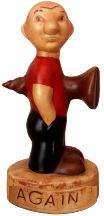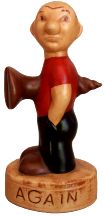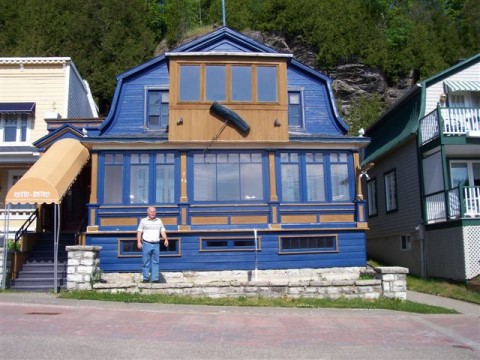 |
 The Virtual Corkscrew Museum's Weekly Newspaper |
 |
 |
 The Virtual Corkscrew Museum's Weekly Newspaper |
 |
|
Sunday, August 17, 2008 |
Number 530 |
Max Duncan
Yet another American patent with a corkscrew has turned up. Ron MacLean writes: "I recently acquired this can opener with 1900 Clough patent wire helix in the wood handle end. The body marked THE 'STERLING' PAT’D AUG 26, 1902 MADE BY THE STERLING HARDWARE NEW YORK I believe the steel ferrule covers a few words in the hardware name and address. It is in excellent mechanical condition except has only traces of the original plating remains. It is similar to the common White / Winkler models of 1904 but much less expensive to manufacture."
We did a Google patent search for 1902 can openers and turned up two by Max Duncan of New York City: 707,560 and 707,561. The first patent was filed on April 8, 1901 followed by the second on May 1, 1901. Both patents were granted on August 26, 1902. The first patent has a drawing which resemble the handle on the "Sterling".
Compare Duncan's patent to the White and Winkler patent of 1904. White and Winkler do not show a corkscrew in their patent either.
White & Winkler
Reprinted from the July 3, 2003 issue with additions
In March of 1903, Frank White and Fred Winkler applied for a patent on their new can opener. On July 3, 1904 United States Patent 765,450 was issued to the pair and Fred assigned his rights to Frank. The thrust of their "Can-Opener" patent was to provide a tool that could cut the tops off cans either in a circle or a straight line with a means for catching the cut portion. While it was not a part of their claim, the head of the implement included a bottle cap lifter.
The tool was marketed under the name Sure-Cut and was produced with a variety of shapes of wood handles. Some of the handles were drilled out on the end to accommodate a Clough wire type corkscrew. The tool was also sold for advertising purposes with the round handle allowing plenty of room for a message. One Detroit, Michigan example reads "Compliments of The Peerless Products Company, Manufacturers of High Grade Liquid Malt Extract Already Prepared, 3520 Mitchell Near Gratiot, Phone Melrose 2464, 5046, 5047, We Deliver."
The bar of the handle is marked "SURE-CUT" CAN OPENER PAT. 7-19-04. Two versions of the head can be found. The first like the patent drawing has a slot to slide it onto the bar and it is held in place by one rivet. It is marked CAP LIFTER CAN OPENER. The later version required less bending to manufacturing by eliminating the slot and fastening the head with two rivets. The head was also used on the more common type loop metal handle.
On the second page of the White and Winkler patent drawings is a can opener / bottle cap lifter head which includes a Prest-O-Lite key. The combination tool with Clough corkscrew has the Prest-O-Lite key in a different position and the markings are CAP LIFTER PATD 19 - 04, CAN OPENER, TEMPERED, PREST-O-LITE.
Edward Woods
On August 11, 1900 Edward Woods of New York filed for a patent on his can opener. The interesting thing about the patent is that it was assigned to Frank White, inventor of the Sure Cut (above) and to Byron Bacon. And Byron Bacon is the same guy Duncan (the Sterling) assigned his patent to.
Byron Bacon
Digging a little deeper into Google patents, we find a "Can or Bottle Opener" patent by Byron Bacon of South Orange, New Jersey. He filed for this patent on September 24, 1901 and patent number 692,045 was granted January 28, 1902. This appears to be the same head as used on the "Bull-Dog" combination tool with corkscrew shown below.
So White & Winkler and Duncan assigned patents to Bacon around the period when Bacon got his own unassigned patent. Bacon was a South Orange, New Jersey post office box on his patent applications.
A footnote: On April 16, 1909 Byron Bacon's home on South Prospect Street in South Orange, New Jersey burned to the ground while rival firemen from South Orange Village and South Orange Township argued over which department had exclusive rights to the nearby fire hydrant. Although the fire was under control when the first company arrived, when the second company arrived and hooked up to the same hydrant, there was not enough pressure to extinguish the flames.
Note on the above stories
Given the similarities of the can openers in this issue, we suspect all of these were made by the same firm giving a common link to Duncan, Winkler, White, Woods, and Bacon.
Where are they?
Where is it?
Bottlescrew Bill's Pub sign was submitted last week by Sal Robinson. Reader Robert Cordy was the first to respond with "Calgary, and, of course, Google finds all..." See the July 2, 2006 issue for Bottlescrew Bill's and a few other eateries.
Where is it?

Robert Fraser submitted this one. Regular contributor Jean Grignon quickly responded with "You will find my picture of this restaurant in the August 20, 2006 issue. It is the restaurant at the La Malbaie in Quebec in the region of Charlevoix 75 miles north above Quebec city. The corkscrew has left hand worm. I met the owner, but not able to buy the corkscrew.
|
©2008 Don Bull, Editor |